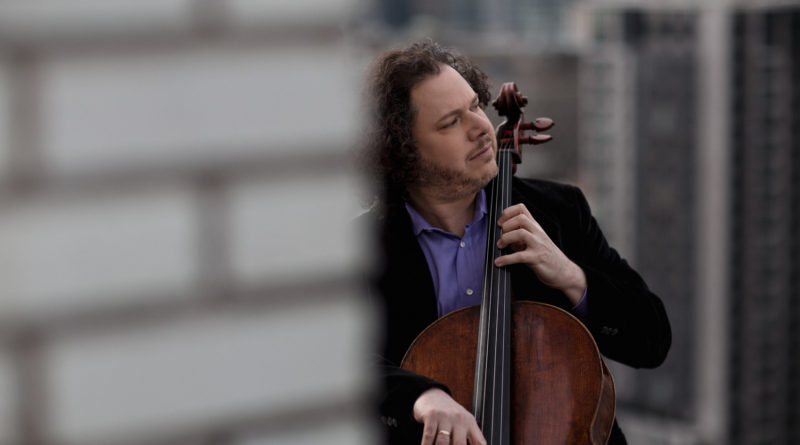INTERVIEW: Matt Haimovitz explores connections between Glass, Beethoven
Photo: Matt Haimovitz is a master cellist who will play with Navah Perlman in New Jersey. Photo courtesy of Brent Calis / Provided by the State Theatre with permission.
When cellist Matt Haimovitz and pianist Navah Perlman take the stage at the State Theatre in New Brunswick, New Jersey, today, Nov. 17, they will take part in an interesting compositional exploration, almost like a living, breathing thesis statement of how music can connect across hundreds of years.
The program for the afternoon includes Beethoven’s “12 Variations on a Handel theme — Judas Maccabaeus” and “Sonata for Cello and Piano in D Major, Op. 102, No. 2.” These pieces alone should come as no surprise, especially given the upcoming celebration for the composer’s 250th birthday.
However, Haimovitz and Perlman are also pairing the works with Philip Glass’s “The Orchard” and “Partita #2 for Solo Cello” (a rendition of Corigliano’s “Fantasia on an Ostinato” will be thrown in for good measure). Although Glass, a contemporary composer, might seem a world away from the Romantic style of his classical-music forebear, for Haimovitz, there are many interesting connections.
“This particular concert is sort of taking Beethoven as a starting point, and he’s really the composer who put cello and piano on the map,” Haimovitz said in a recent phone interview. “Beethoven returned to this genre three times in his career, and these are ‘Variations,’ which are really underestimated, stunning and very beautiful variations for cello and piano that we’re playing in the first half. And then the second half, the great ‘Opus No. 2,’ the last sonata of Beethoven, where you see a real window into his late style, and that is sort of where the connection to Philip Glass is. Beethoven is the first modernist, and then from there we jump to one of America’s most important composers. We have this juxtaposition. … So I think it will give an audience a chance to experience the instruments on their own and in a more contemporary context through the Philip Glass lens, and then how does Beethoven put these two very disparate instruments together, and how does he get them to talk to each other and get along and create something that’s larger than the parts.”
Haimovitz, who made his debut at age 13 with Zubin Mehta and the Israel Philharmonic, has a personal connection to Glass’s “Partita #2” because he was actually the first cellist to interpret the challenging work. Here’s how the story goes.
“It sat in a drawer for seven years, and nobody played it,” the cellist said. “Philip wrote it, and one day I was at his place in Manhattan. And he said, ‘Would you read this for me? I want to see what it sounds like.’ It’s this epic, 30-minute work with multi-movements modeled after Bach’s cello suite, but in Philip’s language — actually less minimalist, more neo-Romantic and very personal and just stunningly beautiful with very simple means.”
As an example, “Partita #2” features a final movement all in G minor, which Haimovitz called hauntingly beautiful and wonderfully simple. The penultimate movement is virtuosic, by contrast, and can almost stand alone.
“Philip doesn’t give you a lot of instructions,” said the cellist, who made his first recording at age 17 with the Chicago Symphony Orchestra. “When I saw the music, there were barely any dynamics in it, very little tempo indications, that kind of thing. You have to make sense of it on your own, and with Philip, he’s always concerned about form. You have to immerse yourself in that language and personalize it and make something of it.”
Haimovitz loves playing these intimate concerts and recitals, but he also enjoys his time spent with orchestras around the world. There are unique challenges with solo pieces, where his interpretive skills are on obvious display, and concertos, where his solo work joins with dozens of other musicians to form a tempest of sound.
“I think they’re quite difficult,” Haimovitz said. “[For orchestral music], you’re communicating with 100 people on stage at different times, and with a solo piece, you have to keep track of all these voices yourself. But there are often just as many voices and textures, so I think the challenge is that there’s a responsibility all on your shoulders. … It’s like a painting versus a sculpture. A painting in 2D you still have perspective, and you have to create your own perspective. You have to prioritize and put what you want at the fore and then put the rest in relief, and it’s up to you to do that.”
He added: “But, on the other hand, an orchestra and a cello, it’s always a challenge for the cello to project, and you don’t have that issue when you’re playing alone. So you actually have a wider pallette, a wider dynamic range when you’re playing alone because you can hear a pin drop in the hall. You can really come down and play very intimately, and that creates space for the more climatic moments.”
Another special treat for this duo concert is the chance for Haimovitz to share a stage with Perlman, a fellow musician he has been working with for several decades.
“Navah and I have known each other for 40 years, four decades, and when we were 10 years old, we played our first recital together,” he remembers fondly. “I don’t get to play with her that often, but it’s always a treat. And I’m looking forward to reconnecting with her on stage.”
By John Soltes / Publisher / John@HollywoodSoapbox.com
Matt Haimovitz and Navah Perlman will play Sunday, Nov. 17 at the State Theatre in New Brunswick, New Jersey. Click here for more information and tickets.

